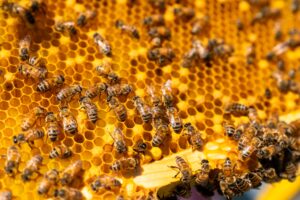Along with the well-known impacts, such as increased weather extremes and rising global temperatures, there are secondary effects.
One of these is food nutrition.
Junk food for plants
Environmental carbon dioxide lets plants photosynthesise more and grow faster.
But there’s a catch.
Excess carbon dioxide acts like plant junk food. It makes plants grow faster but stops them absorbing minerals from the soil.
By 2050, plants will have up to 10% less zinc, 5% less iron and 8% less protein.
“That’s really significant, because they’re key nutrients that we need in our diet. That’s going to have a flow-on effect for the people consuming them,” says Susan McLeod.
Susan is a nutritionist and lecturer at La Trobe University. She was also one of the organisers for Taste Tomorrow, a group dedicated to understanding our future food supply.
Today, 0.2% of global child deaths under 5 are caused by iron deficiency.

That’s over 10,000 deaths per year.
One in nine people worldwide are undernourished, while one in three are overweight. Lower plant nutrition will increase both statistics.
“There are two types of undernutrition. One is the people that are starving, that are not getting enough food, or they’re not getting a diverse range of foods.
“The other one is the people that are consuming foods that are vitamin deficient. They might be eating a lot of food, but it’s junk food. It doesn’t really contain many nutrients,” says Susan.
Australians are the second most voracious meat eaters in the world, but many are moving to plant-based diets.
Ironically, people choosing plant-based diets to help fight climate change are more vulnerable to lower plant nutrition.
So what can we do?
Pills or plant modification
One option is to genetically modify plants to increase their nutrient uptake and make them more climate resistant.
Susan says adding genes from nutrient-rich foods, like seaweed, into our wheat and rice could help boost the nutrition.
Australians are divided on whether to do this; 49% of Australians believe GM food is safe to eat, but the number is growing.
Changing our diets to be more varied could help too. Australians traditionally eat processed grains, like wheat and white rice, though this is changing.
A varied diet protects against malnutrition, but food variety is a luxury. Low-income Australians currently spend up to 40% of their income on food, with the cost of healthy foods in Australia rising faster than the cost of less-nutritious foods.
We can’t tell them to simply buy more. Artificially adding nutrients could help, but it opens up a can of worms.

Vitamins are poorly regulated, and there’s a lack of scientific evidence that they can replace nutrients.
“Every time we process a food or try to edit another nutrient in, it changes the impact to our bodies and our diet. There are flow-on effects too that we need to investigate.”
Speaking of a can of worms, Susan thinks insects might be one avenue for adding extra protein and iron into our diet.
Bug burgers
Insects are cheaper and more ethical and have a smaller carbon footprint than other high-nutrient sources. They could be a great alternative if we could get over the ick factor.
“Insect farms didn’t exist in Australia 10 years ago. Now, we can buy cricket meal. There’s a whole range of things that you can get that are made with insects.”
Susan says no single approach will be enough to deal with changing plant nutrition.
We’ll need all of these approaches and more if we want to stay healthy as our climate changes.









